Implant Dentistry
What Is A Dental Implant?
What Is A Dental Implant?
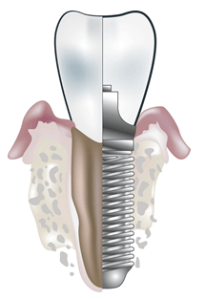
Simply put… a dental implant is an artificial tooth root.
More specifically, a dental implant is quite literally a screw-shaped titanium or ceramic post which we surgically place in the jawbone.
Once in place, the surrounding bone and tissue begins to grow next to, around, and “grab onto” the implant in a process called osteointegration. The implant is “made part of” the jawbone providing the artificial root we need to replace your missing tooth. Surprisingly, the surgical placement of a dental implant is much easier for the patient than most extractions.
If you have several, or even all, of your teeth missing and if the surrounding bone is strong enough, multiple dental implants can be placed in order to support a fixed bridge (several teeth attached together and attached to the implants). This procedure actually helps save any adjacent teeth since your neighboring teeth are not used to support the bridge.
Are All Dental Implants The Same?
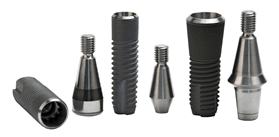
Standard implants are typically wider, longer and stronger, and they’re used in patients with a good amount of bone mass. These implants are shaped quite literally like a screw, but, instead of the “flat head” or “Phillips” head we are used to seeing, they have another set of internal threads which allow us to screw a variety of angled attachments into the standard implant in order to properly position your crown or bridge.
Mini implants are one piece with a “trailer hitch” ball on top that snaps into an O-ring female assembly that is embedded in your denture or partial. They can even be used with crowns to replace genetically missing teeth, especially anterior (front) incisor teeth. These implants are much smaller so they can be placed when there is less bone mass. Talk to a typical denture wearer and you will soon find out that stable, comfortable mini implant dentures can mean a happier, healthier, life-changing experience!
What Are The Benefits Of A Dental Implant?
Can Anyone Get Dental Implants?

In most cases, if you are healthy enough to undergo routine dental procedures or oral surgery, and have good oral hygiene (no gum disease), then you are almost on your way.
But if you are a heavy smoker or have uncontrolled diabetes, heart disease or other medical condition, you may have to address these conditions before proceeding since they may reduce the success rate of the implants. The last thing we need to determine is whether you have enough bone mass in your jaw to accommodate the size and placement of implants.
In our office, we do this with the help of a very special machine called a Cone Beam Computed Tomography (CBCT) scanner. Using this high tech 3D digital scanning, we are able to see a cool three-dimensional picture of your mouth structures including your teeth, bone, sinuses, nerves, etc. When considering dental implants, we are looking to see if there is enough bone structure to accommodate the implants and exactly where to safely place them.
You might ask, “Why wouldn’t I have enough bone?” The answer lies in your overall health, genetics and how many teeth you have been missing for how long. You see, your body does funny things when it’s missing teeth. When a tooth is missing in a particular area, there is nothing for the opposite tooth to chew against. After a while, the body realizes there no reason to have a bunch of bone in that area. So the bone is, to a greater or lesser degree, reabsorbed by the body and those resources are used elsewhere. This process is magnified for patients that have lost or had all of their teeth pulled in preparation for dentures. That is one reason why dentures are usually supported with mini-implants.
What’s Involved In Getting A Dental Implant?
Once we have determined whether you are a candidate, we carefully map out the exact size and location for the implant with the use of a high tech 3D scan. After gently applying a conscious sedation and local anesthesia, the implant is surgically placed below the gum tissue in the bone structure of either the upper or lower arch of your mouth. Once placed, you are usually sent home for a few weeks or months to let the implant “heal” and integrate with the surrounding bone and tissue. This takes time but it allows for a good solid structural support for the rest of your reconstructive dentistry. When you return, the implant is uncovered with a laser procedure and an attachment that sticks up above the gum line is secured to the implant. Then, using that attachment as a foundation, a corresponding crown is created and secured in place. Voila! Your tooth is replaced!
There is also another implant technique called “immediate placement and loading” whereby the standard implant is placed immediately after the extraction of a natural tooth. This procedure normally entails also placing some bone graft materials in the socket along with the implant to help it integrate with the surrounding bone and tissue to ultimately form a good dense bony base to support it.
By the way, in case you were wondering, we use only artificial bone graft material which is sterile, granular mineral which is the consistency of wet sand. It is similar to, but not, bone. Even if you are not quite ready for a dental implant, bone grafting the tooth socket after an extraction definitely keeps your options open for the possibility of replacing that tooth with an implant in the future!
A Single Dental Implant Or A Fixed Bridge?
For many years, teeth have been replaced using both methods and each has its own advantages.
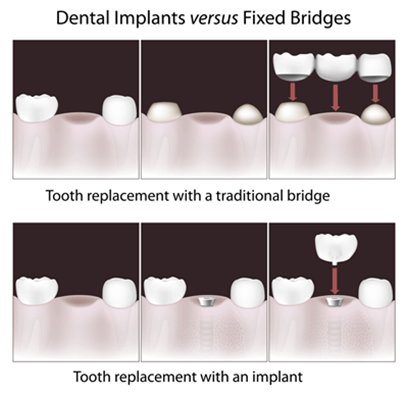
The best bridges (several crowns attached together) are those that are cemented in — called “fixed bridges”. They require support from, and the crowning of, your teeth on either side of the missing tooth and they do require a little more effort when it comes to flossing under them. Fixed bridges work great if your supporting teeth also happen to need crowns.
If your neighboring teeth are sound, it is better to place a dental implant where the tooth is missing. A single crown is then cemented on top of the implant. This way, you can brush and floss normally between your teeth. Even though it entails more time, cost and effort, the implant way is generally best since it should serve you a lifetime. In fact, dental implants, depending on the tooth’s purpose, location in your mouth and your overall all health, have up to a 95% long term success rate and that’s good in anybody’s book!
What Are Implant Dentures?
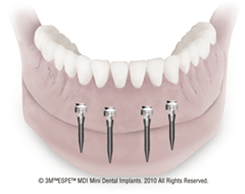
If you need dentures or, unfortunately, have loose dentures, mini dental implants could provide the support necessary to create a strong stable denture fit! They are much smaller implants so they can be placed when there is less bone mass, which is very typical in seniors and anyone who has lost some or all of their natural teeth. These mini implants are one piece with a “trailer hitch” ball on top that snaps into an O-ring female assembly that is embedded in your denture or partial.
The implant technique is called “immediate placement and loading” whereby several mini implants are placed, with bone graft material if needed. By adding some artificial bone graft material to the sockets, we help the implants integrate with the surrounding bone and tissue to ultimately form a good dense bony base to support it.
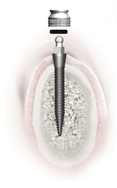
When you already have loose dentures and the implants are placed, your denture is immediately modified to accommodate the mini implants. You simply wear it home and follow the aftercare directions. And with that you can throw away the denture adhesives, eliminate the fear of “denture drop” when speaking to your family and friends and start enjoying your favorite foods again! Believe it or not, research shows a good stable bite can add 10-20 years to your life!
FAQ About Dental Implants
How do I care for my dental implants?
Whether restored with a corresponding crown or a denture attachment, it is important to brush and floss your dental implants just as you would your natural teeth. You should be brushing after any meal or snack, and flossing at least once per day. If you have also been instructed to use a periodontal irrigator, use that once per day as well after your brushing and flossing. Poor oral hygiene is one of the biggest reasons why implants fail. We also recommend professional cleanings and/or periodontal (gum health) maintenance up to four times a year. When you have dental implants, it is absolutely necessary to promote and support healthy gums.
Do dental implants ever fail?
Yes, of course there are failures, but when weighed against a 90-95% success rate, you can see that the chances of failure are low. Failure can be for any number of reasons: rejection by the body, failure to integrate, genetics, medications, infections, failure to follow proper home care and professional maintenance, and others.
Do dental implants feel weird or different in my mouth?
No, usually you can’t even tell they are there. They feel “like they grew there.”
Is it worth the time and expense to get dental implants?
That is a personal choice and preference, but overall, as long as you are an implant candidate, they are usually the best solution for missing teeth. The expense is higher compared to other options due to the surgeries required, the high cost of the implants, parts and equipment, as well as the necessary extra training (which can be thousands of dollars per day) that your dentist must have just to place them.
How long will dental implants last?
That’s a hard one to say exactly, but from numerous studies, we now know that the 5 year success rate average is over 95%. And with excellent care, many could last a lifetime!
Why do I need to replace a missing tooth?
Teeth that are not replaced cause problems. Your other teeth above and beside the empty spot will shift around and be unbalanced. You lose your chewing ability in that area because the partner tooth above or below has nowhere to chew. Missing teeth usually need to be replaced by some means and the most desirable way is with dental implants, followed by fixed or removable bridges.
